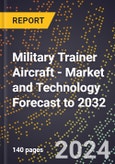The global military trainer aircraft market is projected to grow to US$18.01 billion throughout the 2024-2032 period, with a CAGR of 3.5%. The North American market will account for the largest share thanks to the US Air Force’s induction of new advanced trainers and the upgrades of the fleets in the two other segments.
The international system presents major challenges with competition among great powers being back at the forefront. However, low-intensity conflicts are present in several regions of the world. Under this framework, air power provides the force multiplier and the tools to project power at longer distances and in a shorter time, among other advantages. These are elements that drive the market for military trainer aircraft.
Maintaining the necessary capabilities comes at a very high financial cost and so does quality training. The global economic situation can make it even more difficult to sustain the aircraft and cover the rising energy costs. There can be several approaches to these problems that can include the adjustment of the training schedule and the flight hours, the use of a single type of aircraft for the first two stages or using older variants of the aircraft in service, increasing the hours in flight simulators, which can be interconnected to simulate group operations, and finally acquiring training as a service.
While the latter is a different market in itself, it drives the market for trainer aircraft and for older fighter aircraft which can be used in “aggressor” roles.
Covered in this study
- Overview: Snapshot of the Trainer Aircraft technology in the military market during 2024-2032, including highlights of the demand drivers, trends, and challenges. It also provides a snapshot of the spending with respect to regions as well as segments and sheds light on the emergence of new technologies.
- Market Dynamics: Insights into the technological developments in the Military Trainer Aircraft market and a detailed analysis of the changing preferences of governments around the world. It also analyses changing industry structure trends and the challenges faced by the industry participants.
- Segment Analysis: Insights into the various systems market from a segmental perspective and a detailed analysis of factors influencing the market for each segment.
- Regional Review: Insights into modernisation patterns and budgetary allocation for top countries within a region.
- Regional Analysis: Insights into the systems market from a regional perspective and a detailed analysis of factors influencing the market for each region.
- Impact Analysis: Analysis of how certain events will impact the Military Trainer Aircraft market. This will give you an indication of which factors are important for the forecast.
- Key Program Analysis: Details of the top programs in each segment expected to be executed during the forecast period.
- Competitive landscape Analysis: Analysis of the competitive landscape of this industry. It provides an overview of key companies, together with insights such as key alliances, strategic initiatives, and a SWOT analysis.
The publisher has segmented the Military Trainer Aircraft market into three major groups. We've researched these major segments and provided forecast figures for 2024 - 2032. The segments are:
Region
- North America
- Asia Pacific (APAC)
- Europe
- Middle East & Africa (ME&A)
- Latin America (LATAM)
Propulsion
- Propeller
- Jet
Type
- Basic Trainer
- Advanced Trainer
- Intermediate Trainer
Reasons to buy
- Insight on the military trainer aircraft technologies and designs.
- Understanding of the market in terms of demand drivers, industry trends, and the latest technological developments, which shape the market.
- In-depth understanding of other factors affecting the market such as defence spending, operational requirements, and challenges faced by manufacturers, among several others.
- Presenting the disruptions and the technology enablers impacting the market and how these could become an opportunity in this domain.
- Identify opportunities available in the market.
Table of Contents
Companies Mentioned
- Aero Vodochody
- Austro Engine
- Boeing
- Cirrus Aircraft
- CMC Electronics
- Continental Aerospace Technologies
- Diamond Aircraft Industries
- Electric Power Systems
- ELTA Systems
- Embraer
- EuroJet Turbo GmbH
- Garmin
- GE Aerospace
- Hartzell Propeller
- Hindustan Aeronutics Limited
- Hondu Aviation Industries
- Honeywell Aerospace
- International Turbine Engine
- Irkut Corporation
- Ishikawajima-Harima Heavy Industries
- Ivchenko-Progress
- Kawasaki
- Korea Aerospace Industries
- Leonardo S.p.A.
- Lockheed Martin
- Lyooming Engines
- Martin Baker
- MT Propeller
- Northroop Grumman
- NPP Zvezda
- Pilatus Aircraft
- Pratt & Whitney
- RED Aircraft GmbH
- Rotax Asircraft Engines
- Saab Group
- Safran Aircraft Engines
- Sensenich Propeller
- Textron Aviation-Beechcraft
- Textron Aviation-Cessna
- The Boeing Company
- Turkish Aerospace Industries
- Williams International








